New perk! Get after it with local recommendations just for you. Discover nearby events, routes out your door, and hidden gems when you sign up for the Local Running Drop.
In the last few years, we’ve seen the evolution of superbikes go something like this: Give the bike a ridiculously aero shape at all costs; now dial that shape back to match more real-life conditions; now refine that shape further to make it better handling; add disc brakes; now add the stuff a real-life triathlete would need—like nutrition and hydration—and make sure it’s still aero. Though it’s impossible to know when we’re close to the final iteration of the superbike, it feels like we’re getting very close to peak aero bike—that moment when there’s literally nothing more a brand can do, other than simply squeeze a few watts and shave a few grams. With the Plasma 6, Scott has joined the ranks of bike brands that have finally thrown off the yoke of the UCI rulebook, and while Scott hasn’t gone full non-double diamond (and likely never will), their latest bike is an example of what happens when brands truly listen to triathletes and give them something that’s entirely theirs.
RELATED: The Best Triathlon Bikes of 2021
Scott Plasma 6 Extended Review: The Build Rundown
At the bottom of this review, you’ll find the exact spec on the small range of Plasma 6 complete bikes, but below we’ll take a look at the most relevant features, from most important to least:
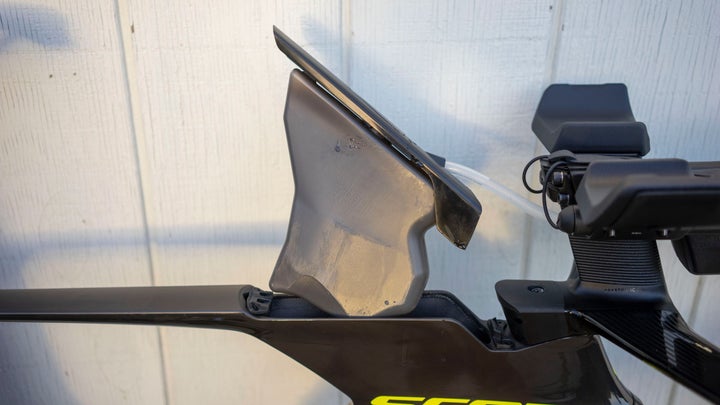
- The storage on the Plasma 6 is both well thought-out and incredibly useful. First, Scott has placed a shape-molded water bottle in the space between the top and downtube that holds either 575mL for the XS and S sizes or 620lL for sizes medium and up. That’s a little bit less than a standard water bottle you could put in a cage and about 100mL less than the extremely similar hydration bladder found on the new Canyon Speedmax CF SLX and CFR.
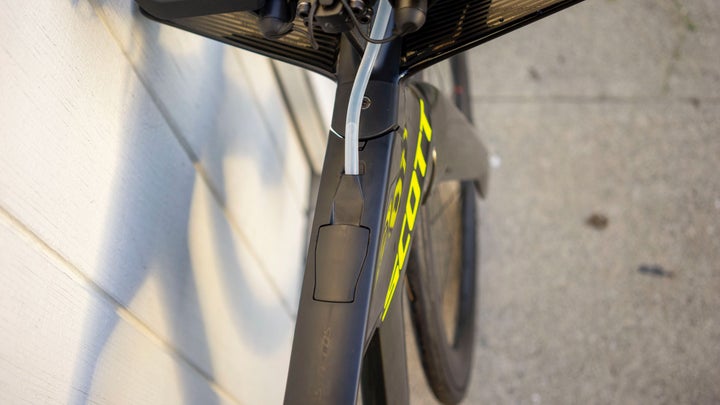
- The Plasma also has a hatch that allows you to fill on the go, and the tube runs out the top of the top tube and attaches via magnet to the aerobars.
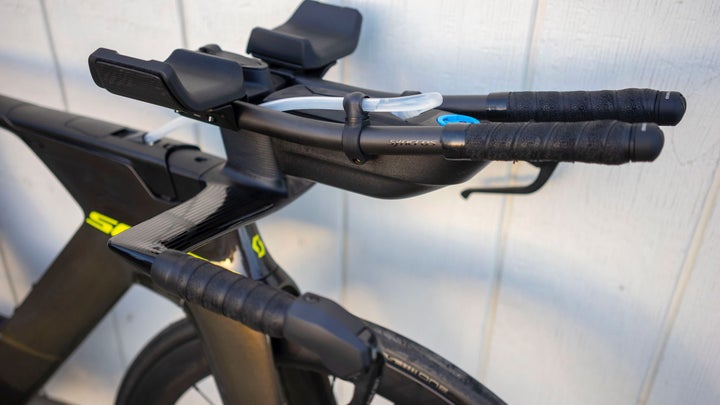
- There’s also a “garage” for nutrition between the aero bars, where you can put things you’d normally store in a bento box—bars, gels, etc.
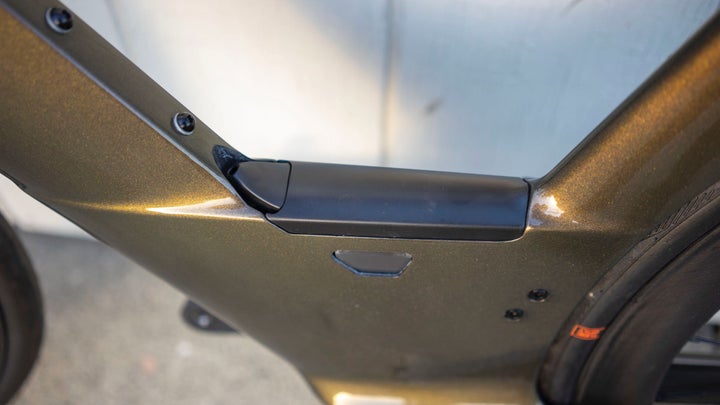
- This bike comes set up with extra nutrition storage in400mL gel-specific storage bottle in the space above the bottom bracket.
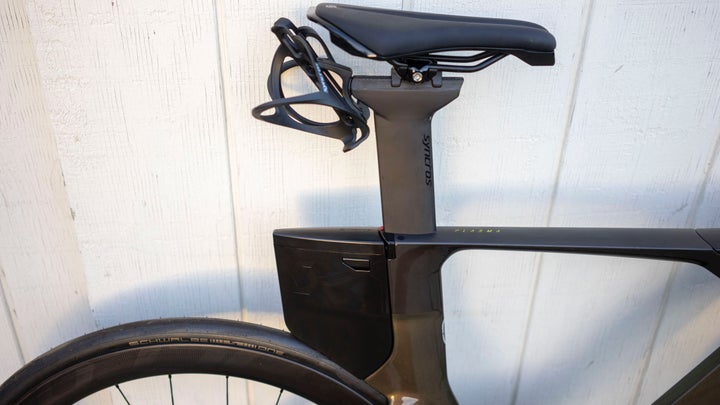
- There’s also plenty of room for behind-the-saddle water storage and a compartment for repair necessities to the rear of the seat tube.
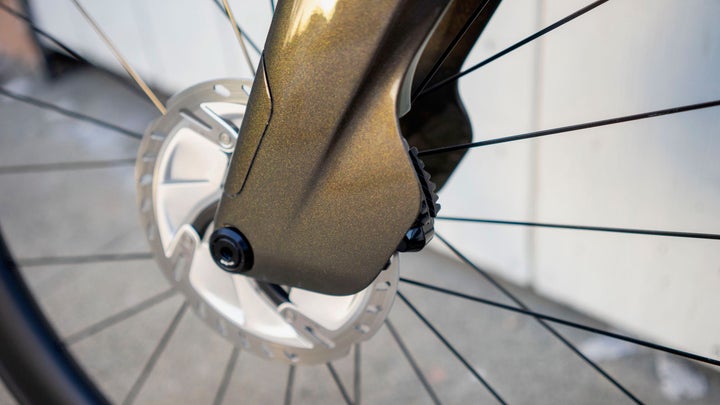
- While we can’t confirm or deny how aerodynamic the Plasma is, it’s safe to say that the design has many unique details that we don’t see on many tri bikes. The fork has a large carbon shroud that covers the hydraulic disc brake caliper, the front wheel is actually further away from the downtube to help in real-world situations (I.e., when you’re actually steering the bike and the front wheel isn’t sitting dead-center, which almost never happens), and the rear wheel can be moved forward and backward to tighten up tire clearance against the frame.
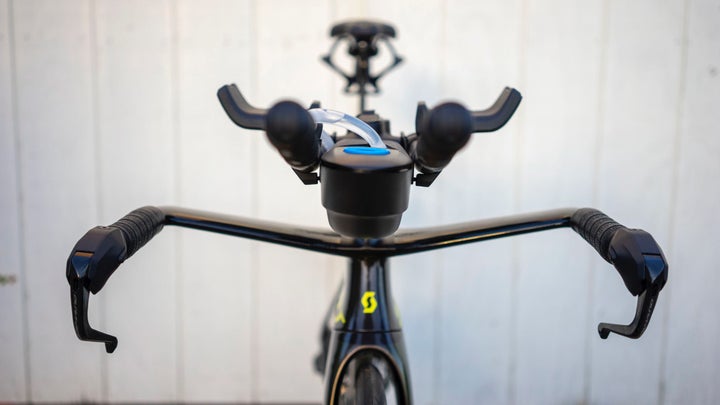
- Like many integrated front ends right now, the Plasma 6 can easily be adjusted by a monopost riser, but the design of their version lends itself to a more secure feeling and less potential for slippage or power transfer loss. Sadly, it also means the front end isn’t quite as surgically clean as, say the new Orbea Ordu or the new Canyon Speedmax CF SLX. And like those two bikes, the Plasma 6 has a monster range of fit adjustability, in fact Scott’s arm pad options are the best of the group.
- While we’re on the topic of arm pads, though the arm cups are well-shaped and give plenty of room for adjustment, sadly the pads themselves are stiff and slightly slippery. This is an easy fix, but a surprising misstep on a detail that Scott should be able to nail pretty easily.
- In terms of value, the price is actually pretty high for something that starts with Ultegra Di2 and a good assortment of house-brand parts, but the novelty of the frame’s design and the fact that you won’t have to sink more money into it to get your nutrition and hydration dialed (and the aero penalties you might pay if you don’t get it right), make it not entirely overpriced. The biggest downside to Scott’s new bike? The fact that they didn’t release something with less expensive parts to give Scott fans a shot at the new frame. Triathletes would have scooped up a sub-$7k version of this bike in droves.
The Fit
Appropriately, Scott makes a pretty big deal of how much time and effort they sank into the fit of this bike. They worked with German bike fitter gebioMized, who may not be super well-known in the U.S., but is the European equivalent of Retül. Because of this, Scott’s Plasma 6 comes in five sizes, from a tiny 50cm top tube with 362mm of reach to a gargantuan 59.5cm top tube with 457mm of reach to the rear of the arm rests. As mentioned before, the integrated front end has tons of space to raise and slam down, and the aerobars themselves rotate up to 15 degrees. The saddle also has a ton of fore-aft adjustment to not only accommodate many different seat tube angle preferences, but also to give ample room for behind-the-saddle hydration storage. As impressed as we were with the new Orbea Ordu’s fit flexibility on their monopost front end, the Plasma 6 has it beat—from the wide saddle play to the insane amount of front-end adjustability to the fact that this is a great bike for huge riders who want to go long and low (or long and moderate). Particularly for larger triathletes who need a big bike (the size XL is quite big) and wide arm pads for big shoulders, the Plasma is a winner.
The Ride
Even before we dug into the fit numbers and the specs on this bike, we took it for a few rides, as you want to get a sense of how the bike feels before you even know the features. Here, Scott hit the nail on the head with hands-down the smoothest riding bike on all frequencies of road roughness (in other words, from tiny little constant bumps to big potholes). This was a surprise given the massive front fork, the aforementioned monopost front end with a novel extension design, and the huge, winged bottom bracket. My best guess is that the smooth ride is a combination of good, expensive carbon and a slightly smaller-than-usual rear triangle. There’s also a chance that the long distance between the front wheel and the downtube has something to do with it too, but that might be more of a handling benefit—which we’ll get to below. However they did it, the Plasma stood out in our big 2021 bike roundup as the smoothest overall, while retaining a snappy acceleration that you often find on really well-tuned road bikes. In other words, this isn’t the stiffest big when you jump on the pedals out of a corner or as you power over a hill, but the frame “springs back” any slight movement it gives for a really lively effect.
Elsewhere, this bike is a total middle-of-the road handler—a good thing for triathletes. If you crave stability, and most triathletes really should, this bike followed a great straight line at all speeds—even when descending at speed in the aerobars. On corners, the Plasma 6 didn’t slice and dice like an Argon or the new Cervelo P5, but it didn’t sweep outwards either, lending itself to cornering that was as confident as its straight line capabilities. All of this is a huge boon for triathletes who often don’t thrive with a twitchy bike and certainly want something that lets them simply plop into the aerobars and churn out miles, quickly and comfortably. In crosswinds the Plasma 6 did fine, but not best in class, though a big part of that could be due to the shallow 50mm spec’d carbon wheels—a tiny sticking point in an otherwise perfect parts list. With a deeper set crosswinds might be more of an issue.
Even with few miles underneath you, I’d imagine you’d get into T2 of a long-course event with the Plasma 6 in a good place, physically, to run well without being beat up by the road or tense from trying to navigate crosswinds or descents.
Scott Plasma 6 Extended Review: Conclusions
Scott has always made very well-featured bikes, but they don’t always hit all of the high notes at the same time. Here, they did. Only by being extremely nit-picky could we find anything even remotely not-perfect about Scott’s Plasma 6. From the crazy amount of fit flexibility that’s basically a bike fitter’s dream, to the aero details that certainly imply excellent numbers into the wind—in real-life conditions—to easily the most balanced and comfortable ride we’ve tested in a few years, this is a bike that Scott should be extremely proud of. Not only that, but Scott has finally shown a full commitment to triathlon by only offering this UCI-illegal setup in its bike line, meaning Scott is no longer straddling the line with a tri/TT rig. This is even more obvious by how excellent their hydration/nutrition storage systems work with the bike.
It’s this final point—the hydration and nutrition—that really stands out in a world where superbikes can already do so much. While we loved a lot about the Specialized Shiv Disc, their integrated hydration system was tough to fill and oddly located. Cervelo inexplicably still hasn’t integrated hydration into its bikes; neither has Orbea or Felt. Canyon and Scott both coincidentally released a very similar system this year, but my nod goes to Scott for a slightly more robust and durable setup and a much more novel way to store gel above the BB and other nutritional goodies between the aero bars. On that same note, the Plasma 6 still has space for a between-the-bars hydration system, whereas the Canyon does not.
If I had to complain about something—and I usually do—it’s that with this release Scott has established themselves as a high-end-only bike brand. Until I hear otherwise, the Plasma 6 RC is the only model of this new design available, and it’s still going to crack your wallet wide open at $10,000. Of course there’s always the ridiculously spec’d Premium version, but that’ll take you all the way up to $15,000. My only hope here is that Scott uses some of the design elements in this new Plasma frame to release a lower-end model with maybe cheaper carbon and certainly lower-end components. If there was a version of the Plasma 6 that came in around $5,000, you’d be looking at something that could compete with all other brands in tri-specific features and ride handling (assuming the ride quality and weight would suffer, of course).
Socialist-style arguments about “a bike for all people” aside, we don’t hand out five-star reviews here very often, but the Scott Plasma 6 has earned it here. This is what you get when you pay close attention to ride quality, the handling characteristics triathletes truly need and the features that will actually get them through their training and racing. Congrats to Scott on a near-perfect bike.
All of our editorial reviews are independent and based on tests by reviewers in the field. Read more about how we test gear.
| Scott Plasma 6 RC | $9,000 |
| FRAME | Plasma 6 Disc / HMX |
| FORK | Plasma 6 Disc 1 1/4"- 1 1/2" Carbon / integrated |
| HYDRATION | 575mL to 620mL integrated hydration, rear saddle cages |
| REAR DERAILLEUR | Shimano Ultegra Di2 RD-R8050 22 Speed Electronic Shift System |
| FRONT DERAILLEUR | Shimano Ultegra Di2 FD-R8050 Electronic Shift System |
| SHIFTERS | Shimano Di2 SW-R9160 Electronic Shift System |
| CRANKSET | Shimano Ultegra FC-R8000 39/53 T |
| BB-SET | Shimano SM-BB71-41B |
| CHAIN | Shimano CN-HG701-11 |
| CASSETTE | Shimano Ultegra CS-R8000 11-28 |
| BRAKE LEVERS | Shimano Di2 ST-R9180 Electronic Shift System |
| BRAKES | Shimano BR-R9170 Hyd.Disc |
| ROTOR | Shimano SM-RT800 CL rotor 160/F and 160/R |
| HANDLEBAR | Syncros Creston iC TRI, 400mm, Syncros E1 Carbon extension |
| SEATPOST | Syncros Plasma 6 HMX with Ritchey WCS clamp adjustable head |
| SEAT | Syncros Belcarra 1.5 TRI |
| HEADSET | Syncros Integrated 1-1 1/8" drop-in headset |
| WHEELSET | Syncros Capital 1.0 50 Disc, tubeless ready 18 Front / 24 Rear Syncros Plug-in RWS |
| TIRES | Schwalbe ONE Race-Guard Fold 700x25C |
| Scott Plasma 6 Premium | $15,000 |
| FRAME | Plasma 6 Disc / HMX |
| FORK | Plasma 6 Disc 1 1/4"- 1 1/2" Carbon / integrated |
| HYDRATION | 575mL to 620mL integrated hydration, rear saddle cages |
| REAR DERAILLEUR | SRAM RED eTap AXS 24 Speed Electronic Shift System |
| FRONT DERAILLEUR | SRAM RED eTap AXS Electronic Shift System |
| SHIFTERS | SRAM eTap AXS EAC Blip |
| CRANKSET | SRAM RED AXS Power meter 50/37 T |
| BB-SET | SRAM DUB PF ROAD 86.5 |
| CHAIN | SRAM RED |
| CASSETTE | SRAM RED XG 1290 10-28 |
| BRAKE LEVERS | SRAM S-900 Aero HRD |
| BRAKES | SRAM S900 HRD flat mount |
| ROTOR | SRAM Centerline XR rotor 160/F and 160/R |
| HANDLEBAR | Syncros Creston iC TRI, 400mm, Syncros E1 Carbon extension |
| SEATPOST | Syncros Plasma 6 HMX with Ritchey WCS clamp adjustable head |
| SEAT | Syncros Belcarra 1.0 TRI |
| HEADSET | Syncros Integrated 1-1 1/8" drop-in headset |
| WHEELSET | Zipp 808 NSW carbon clincher, tubeless ready Syncros Plug-in RWS |
| TIRES | Schwalbe PRO ONE TT Microskin, TL-Easy, Fold 700x25C |
